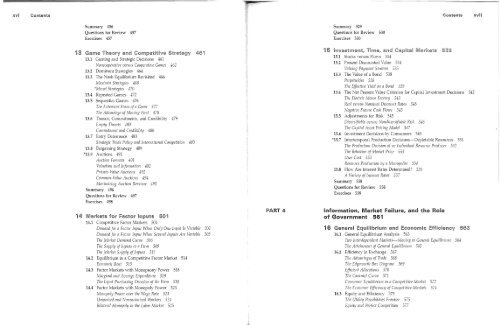Daniel l. Rubinfeld
Daniel l. Rubinfeld
Daniel l. Rubinfeld
Create successful ePaper yourself
Turn your PDF publications into a flip-book with our unique Google optimized e-Paper software.
xvi<br />
Contents<br />
Contents<br />
xvii<br />
Summary 456<br />
Questions for Review 457<br />
Exercises 457<br />
13 461<br />
13.1 Gaming and Strategic Decisions 461<br />
Noncooperative versus Cooperative Games 462<br />
13.2 Dominant Strategies 464<br />
13.3 The Nash Equilibrium Revisited 466<br />
Maximin Strategies 468<br />
'Mixed Strategies 470<br />
13.4 Repeated Garnes 472<br />
13.5 Sequential Garnes 476<br />
The Extellsive Form of a Game 477<br />
The Advantage of Moving First 478<br />
13.6 Threats, Commitments, and Credibility 479<br />
Empty Threats 480<br />
Commitment and Credibility 480<br />
13.7 Entry Deterrence 483<br />
Strategic Trade Policy and International Competition 485<br />
13.8 Bargaining Strategy 489<br />
*13.9 Auctions 491<br />
Auction Formats 491<br />
Valuatioll alld Informatioll 492<br />
Private-Value Auctions 492<br />
Common-Value Auctions 494<br />
Maximizing Auction Revenue 495<br />
Summary 496<br />
Questions for Review 497<br />
Exercises 498<br />
14 Marh:.ets for factor Inputs 501<br />
14.1 Competitive Factor Markets 501<br />
Demalldfor a Factor Input Wilen Only One Input Is Variable 502<br />
Demand for a Factor Input lr\fllen Several Inputs Are Variable 505<br />
The Market Demand Curve 506<br />
The Supply of Inputs to a Firm 509<br />
The iVlarket Supply of Inputs 511<br />
14.2 Equilibrium in a Competitive Factor Market 514<br />
Economic Rent 515<br />
14.3 Factor Markets with Monopsony Power 518<br />
Marginal alld Average Expellditure 519<br />
The Input Purchasing Decision of the Firm 520<br />
14.4 Factor Markets with Monopoly Power 523<br />
Monopoly Power over the Wage Rate 523<br />
Uniollized and Nonllllionized Workers 524<br />
Bilateral Monopoly in the Labor Market 525<br />
PART 4<br />
15<br />
Summary 529<br />
Questions for Review 530<br />
Exercises 530<br />
15.1 Stocks versus Flows 534<br />
15.2 Present Discounted Value 534<br />
Valuing Payment Streams 535<br />
15.3 The Value of a Bond 538<br />
Perpetuities 538<br />
The Effective Yield Oil a BOlld 539<br />
15.4 The Net Present Value Criterion for Capital In\"estment Decisions 542<br />
The Electric Motor Factory 543<br />
Real versus Nominal Discoullt Rates 543<br />
Negatiz1e Future Cash Flows 545<br />
15.5 Adjustments for Risk 545<br />
Dh1ersifiable versus Nondiversifiable Risk 546<br />
The Capital Asset Pricing Model 547<br />
15.6 Investment Decisions bv Consumers 549<br />
*15.7 Intertemporal Production Decisions-Depletable Resources 551<br />
The Production Decisioll of all Individual Resource Producer 552<br />
The Behavior of Market Price 553<br />
User Cost 553<br />
Resource Productioll by a Monopolist 554<br />
15.8 How Are Interest Rates Determined 555<br />
A Variety of Interest Rates 557<br />
Summary 558<br />
Questions for Review 558<br />
Exercises 559<br />
Information, Market Failure, and the Role<br />
of Government 561<br />
16 General Equilibrium and Economic Efficiency 563<br />
16.1 General Equilibrium Analysis 563<br />
Two Interdependent Markets-Moping to General Equilibrium 564<br />
The Attainment of General Equilibrium 565<br />
16.2 Efficiency in Exchange 567<br />
The Adz1alltages of Trade 568<br />
TIle Edgeworth Box Diagram 569<br />
Efficient Allocations 570<br />
The Contract Curve 571<br />
Consumer Equilibrium in a Competitive Market 572<br />
The Ecollomic Efficiellcy of Competith1e Markets 574<br />
16.3 Equity and Efficiency 575<br />
The Utility Possibilities Frolltier 575<br />
Equity and Pelfect Competitioll 577

















